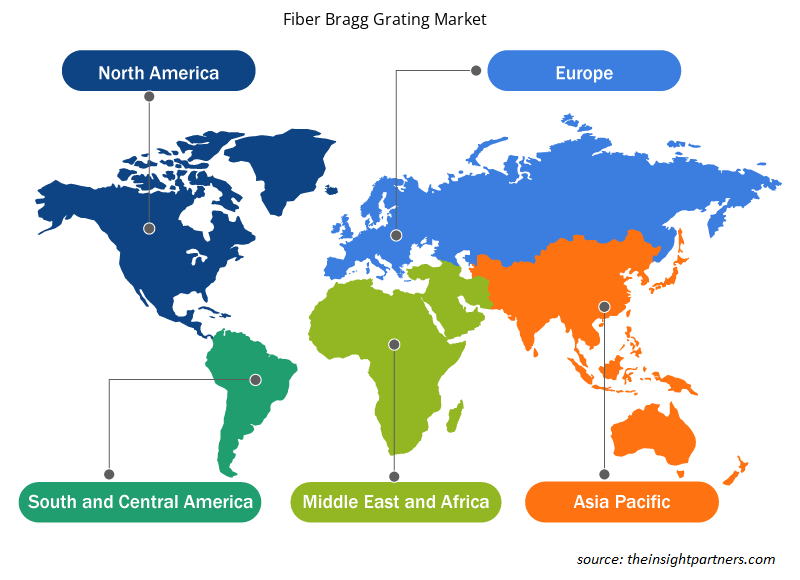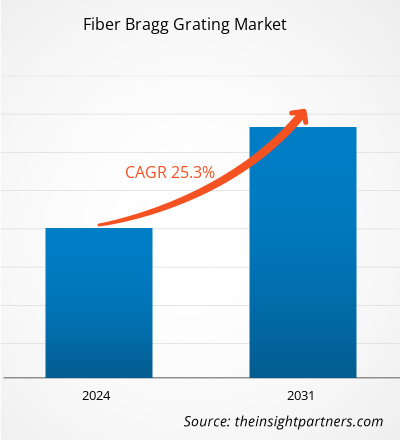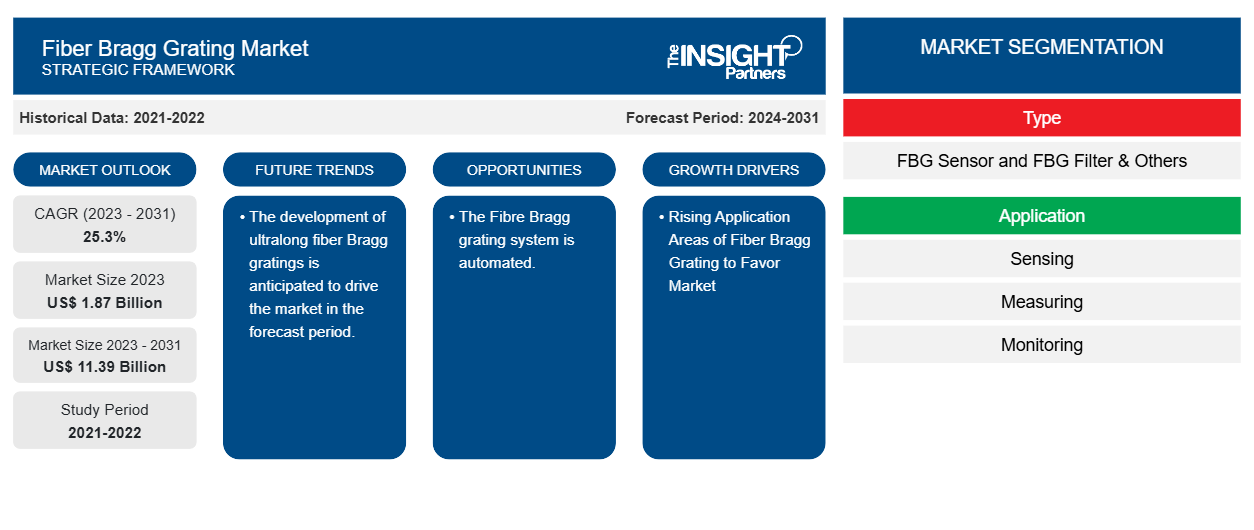光纤布拉格光栅市场规模预计将从 2023 年的 18.7 亿美元增至 2031 年的 113.9 亿美元。预计 2023-2031 年期间市场复合年增长率将达到 25.30%。光纤布拉格光栅 (FBG) 应用领域的不断扩大以及由于其优势而不断增加的采用率可能仍是市场的主要趋势和驱动因素。
光纤布拉格光栅市场分析
光纤布拉格光栅市场正在全球范围内经历显著增长。这种增长归因于光纤布拉格光栅 (FBG) 应用领域的不断扩大以及 FBG 因其优势而得到日益广泛的采用。此外,自动化 FBG 系统的实施和超长光纤布拉格光栅的开发预计将为市场带来诸多机遇。
光纤布拉格光栅市场概况
光纤布拉格光栅 (FBG) 是一种微结构,通常长度为几毫米,可通过光刻技术刻印在单模光纤的纤芯中。这是通过用紫外激光束横向照射光纤并使用相位掩模在其纤芯中产生干涉图案来实现的。这将导致二氧化硅基质的物理特性发生永久性变化。
定制此报告以满足您的需求
您可以免费定制任何报告,包括本报告的部分内容、国家级分析、Excel 数据包,以及为初创企业和大学提供优惠和折扣
- 获取此报告的关键市场趋势。这个免费样品将包括数据分析,从市场趋势到估计和预测。
光纤布拉格光栅市场驱动因素和机遇
光纤光栅应用领域不断扩大,市场青睐。
光纤布拉格光栅的应用领域不断扩大,推动着光纤布拉格光栅市场的发展。光纤布拉格光栅用于电信、航空航天、能源和公用事业、交通运输等行业。FBG 是电信的关键元素。与电信应用中将 FBG 紫外刻印到石英光纤中相比,这已发展成为一种标准且高度可重复的大规模生产工艺。此外,空间相位光栅(频率)的作用本质上是在核心中形成窄带(透射或反射)滤波器或镜子。因此,考虑到上述参数,光纤布拉格光栅应用领域的扩大正在推动市场增长。
光纤布拉格光栅系统是自动化的。
FBG 具有独特的传感器性能。光纤布拉格光栅 (FBG) 传感器体积小、灵敏度高、抗电磁干扰,广泛应用于自动化等各种应用。这些传感器通过反射特定波长的光并传输其他波长的光来工作,其中反射波长会随着温度、应变或压力的变化而变化。FBG 用于自动化的各个步骤,包括确定测量目标、选择 FBG传感器、与设备集成、连接到光学询问器、校准等等。因此,考虑到光纤布拉格光栅在自动化中的上述优势和特点,预计未来几年市场将会增长。
光纤布拉格光栅市场报告细分分析
有助于得出光纤布拉格光栅市场分析的关键部分是类型、应用和行业。
- 根据类型,光纤布拉格光栅市场分为 FBG 传感器、FBG 滤波器及其他。预计 FBG 传感器部分将在预测期内占据相当大的市场份额。
- 根据应用,光纤布拉格光栅市场分为传感、测量、监控和其他。传感部分预计在预测期内占据相当大的市场份额。
- 根据行业,市场分为电信、航空航天、能源和公用事业、运输等。预计电信在预测期内将占据相当大的市场份额。
光纤布拉格光栅市场份额按地区分析
光纤布拉格光栅市场报告的地理范围主要分为五个区域:北美、亚太、欧洲、中东和非洲、南美和中美。
北美主导着光纤布拉格光栅市场。北美市场分为美国、加拿大和墨西哥。这种增长归因于该地区光纤布拉格光栅应用领域的不断增加以及由于其优势而越来越多地采用 FBG。此外,自动化 FBG 系统的实施和超长光纤布拉格光栅的开发预计将为市场带来许多机会。此外,美国和加拿大发达经济体高度重视研发,这迫使北美参与者将技术先进的解决方案引入市场。此外,美国拥有大量光纤布拉格光栅市场参与者,他们越来越专注于开发创新解决方案。所有这些因素都促进了该地区光纤布拉格光栅市场的增长。
光纤布拉格光栅市场区域洞察
Insight Partners 的分析师已详细解释了预测期内影响光纤布拉格光栅市场的区域趋势和因素。本节还讨论了光纤布拉格光栅市场在北美、欧洲、亚太地区、中东和非洲以及南美和中美的细分市场和地理位置。

- 获取光纤布拉格光栅市场的区域特定数据
光纤布拉格光栅市场报告范围
| 报告属性 | 细节 |
|---|---|
| 2023 年的市场规模 | 18.7亿美元 |
| 2031 年市场规模 | 113.9亿美元 |
| 全球复合年增长率(2023 - 2031) | 25.3% |
| 史料 | 2021-2022 |
| 预测期 | 2024-2031 |
| 涵盖的领域 | 按类型
|
| 覆盖地区和国家 | 北美
|
| 市场领导者和主要公司简介 |
|
光纤布拉格光栅市场参与者密度:了解其对业务动态的影响
光纤布拉格光栅市场正在快速增长,这得益于终端用户需求的不断增长,而这些需求又源于消费者偏好的不断变化、技术进步以及对产品优势的认识不断提高等因素。随着需求的增加,企业正在扩大其产品范围,进行创新以满足消费者的需求,并利用新兴趋势,从而进一步推动市场增长。
市场参与者密度是指在特定市场或行业内运营的企业或公司的分布情况。它表明在给定市场空间中,相对于其规模或总市场价值,有多少竞争对手(市场参与者)存在。
在光纤布拉格光栅市场运营的主要公司有:
- AOS有限公司
- Alnair 实验室公司
- FBGS 技术有限公司
- HBM 光纤传感有限公司
- ITF 技术公司
- Ixblue 光子学
免责声明:上面列出的公司没有按照任何特定顺序排列。

- 获取光纤布拉格光栅市场顶级关键参与者概览
光纤布拉格光栅市场新闻和最新发展
光纤布拉格光栅市场通过收集一手和二手研究后的定性和定量数据进行评估,其中包括重要的公司出版物、协会数据和数据库。光纤布拉格光栅市场的一些发展如下所列:
- 光子学领导者之一 TeraXion 推出了一系列新型高功率全光纤布拉格光栅陷波滤波器。WSF 系列是全光纤带阻(陷波)滤波器,用于选择性地衰减或阻挡波长或波长范围,同时允许其他波长通过。(来源:TeraXion 公司网站,2024 年 12 月)
光纤布拉格光栅市场报告覆盖范围和交付成果
“光纤布拉格光栅市场规模和预测(2021-2031)”报告对以下领域进行了详细的市场分析:
- 光纤布拉格光栅市场规模及全球、区域和国家层面所有主要细分市场的预测
- 光纤布拉格光栅市场趋势以及市场动态,如驱动因素、限制因素和关键机遇
- 详细的 PEST/波特五力分析和 SWOT 分析
- 光纤布拉格光栅市场分析涵盖主要市场趋势、全球和区域框架、主要参与者、法规和最新市场发展
- 行业格局和竞争分析,涵盖市场集中度、热图分析、知名参与者以及光纤布拉格光栅市场的最新发展
- 详细的公司简介
- 历史分析(2 年)、基准年、预测(7 年)及复合年增长率
- PEST和SWOT分析
- 市场规模、价值/数量 - 全球、区域、国家
- 行业和竞争格局
- Excel 数据集
近期报告
相关报告
客户评价
购买理由
- 明智的决策
- 了解市场动态
- 竞争分析
- 客户洞察
- 市场预测
- 风险规避
- 战略规划
- 投资论证
- 识别新兴市场
- 优化营销策略
- 提升运营效率
- 顺应监管趋势





















 获取免费样品 - 光纤布拉格光栅市场
获取免费样品 - 光纤布拉格光栅市场